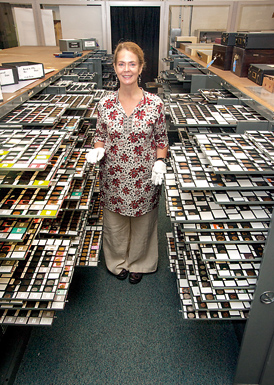Making museums come alive
There was nothing about Karen Lee’s early life that destined her for the job she has now, that of a curator with the Smithsonian Institution’s National Numismatic Collection in Washington D.C. “We’re Czechoslovak immigrants and my family didn’t feel comfortable in museums,” she says, “We were a lower middle class family. I was not taken to museums as a child; I was not given the gift of culture per se.” While some might perceive this as a disadvantage, for Karen it lent her an unconventional perspective.
She believes 75 % of people in the U.S (and perhaps even more people around the world) still share her family’s qualms. Since she feels strongly that “museums can be places for everyone” it has led her to really challenge the status quo and invent new ways of engaging diverse audiences. She has even gone as far as to take the museum’s greatest treasures out of their display cases and out on tour –allowing millions access to some of America’s greatest treasures.

Karen Lee has worked at the Smithsonian for close on 30 years
“Museums around the world are struggling with why they matter within society,” Karen says. “Everybody feels like the internet has definitely levelled the playing field.” Museums can no longer lay claim to being the solitary storehouses of knowledge and informationis abundant (even if some of it is inaccurate). “If that’s not what museums are good for, what are we good for in the 21st century?” she asks. “It’s about taking a hard look at what we do and who we do it for.” In Colombo last week at the behest of the American Centre, she delivered a lecture on ‘The Power of Curating: Making Museums Come Alive’.
Karen ties her talk into her theme of re-examining her approach as a curator – “It’s about involving different communities, people whose voices don’t necessarily feel like they previously belonged.”
There is also another reason Karen would have laughed if someone had told her where she’d end up – she didn’t have the slightest interest in numismatics or the study of coins and currency until she walked into that Smithsonian’s Numismatic Department 10 years ago. She was called in to help manage a crisis. The institution’s decision to ‘mothball’ a celebrated coin exhibit had sparked public uproar. Her mandate was to do a little triage work, find some funds and get a small exhibit opened again.
“But after I raised the money, built the exhibit, got to know the senior curator, I absolutely fell in love with the collection and I just didn’t want to leave it to go off and work on someone else’s crisis,” she says, revealing it marked the beginning of a very real affection for numismatics.
Having graduated with a degree in biology, with a Masters in Museum Science tacked on later, Karen is largely self-taught. “Actually, I like to tell women and girls this about myself,” she says, explaining that she uses her personal journey to illustrate how simply embracing curiosity can lead you in unexpected and wonderful directions. Karen is keenly aware of how female numismatists are a rare breed in the U.S. She says thinking about how to display, interpret and position the Smithsonian’s many numismatic objects so that they resonate better with women is a focus for her personally.
Karen has worked at the Smithsonian for close on 30 years (she actually started out as a research assistant in the botany department). Working in the world’s biggest museum complex is simply “awesome”, says Karen. She counts herself particularly lucky, that the objects of her fascination – some 1.5 million numismatic treasures – are all stored in a vault in the same building.
As lucky as she counts herself to be working at the Smithsonian, she says expecting everyone who wants to see these historical riches to visit the museum is both “impractical” and “not collaborative.” Its why, despite being initially sceptical about the public’s interest, she created the Smithsonian travelling coin programme. As part of it, the Smithsonian agreed to take one of their most prized coins on a tour of seven European cities. Though 500,000 of these gold coins were originally minted, only 13 ‘Double Eagles’ survive today. The historical value of these 13 were multiplied exponentially when the rest were melted down to help to stabilise the American economy by removing gold from circulation during the Great Depression.
Accompanying the coin, Karen was astounded when the final tally came in – an estimated 10 million people had encountered the exhibit in some form, whether through the many media events like the BBC talk show or directly, in person. People standing for hours in a queue in Prague gently corrected her when she asked why they were so interested in American history – it was a piece of world history they had come to see, they said.
The experience has confirmed Karen’s opinion that there’s something special about face to face encounters.She loves meeting people, and says that the numismatic community in Sri Lanka are rolling out a particularly warm welcome. “It’s coinage that I don’t know a lot about and that’s a wonderful thing – that I get to go home and look at our collection and a whole new segment of the collection will become sincerely new to me because of who I met when I come to Colombo,” she says.“I’m so much looking forward to that.”
Follow @timesonlinelk
comments powered by Disqus


